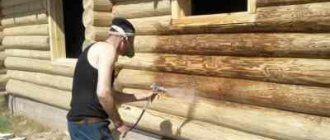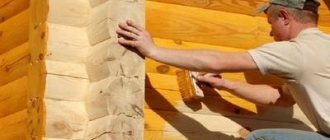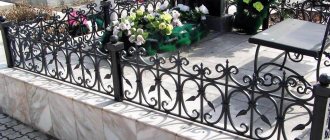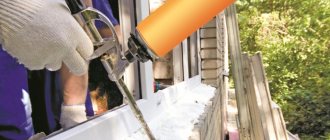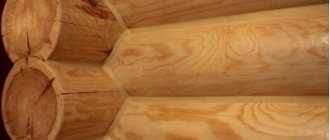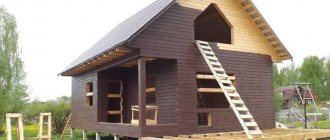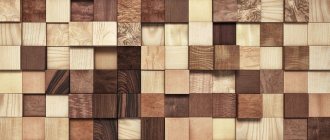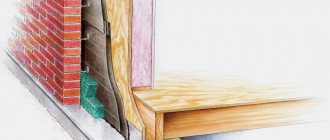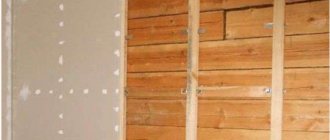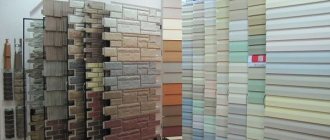A brand new, newly built log house looks just great, and many owners are not going to use any additional coatings. But wood is a living material, subject to various physical and biological negative factors, so very soon it will begin to turn black, and then rotting processes will begin, which will significantly shorten the life of the house.
Because of this and some other reasons, it is imperative to take care of protecting walls and all wooden structural elements with the help of special coatings. What is the best way to treat a log house?
Why process wood?
Wood is a natural material that needs protective treatment from external negative influences. A wooden structure, be it a house or a bathhouse, must be treated with protective compounds. Then the wooden structure will serve you for a long time, without bringing any unpleasant “surprises”. Protective compounds must be applied both externally and internally.
The negative impacts on wood from inside the room are, of course, not as aggressive as outside. However, the wood still needs to be processed. In this article we will tell you what internal impregnations exist to protect wood.
Causes of destruction of wooden structures
Natural, technogenic and anthropogenic factors that can affect the integrity and health of the log walls:
- Ultraviolet radiation destroys lignin, which is the reinforcing framework of wood. When exposed to direct sunlight, outside surfaces darken, become porous, easily absorb moisture and quickly release it. As a result, the logs age prematurely and crack.
- Precipitation and high air humidity lead to swelling and then shrinkage of wooden structures. Damp wood is a favorable environment for the proliferation of fungal microorganisms and mold outbreaks. A rotting corner of a log house can cause the destruction of a house.
- Insect pests and rodents that can settle in the walls of a log house damage the integrity of the tree.
- Exposure to concentrated acid-base solutions affects the chemical composition of the tree and changes its physical properties.
- Fire is one of the most destructive factors that can destroy a wooden frame in a very short period of time.
- Uneven heating of the walls of the house, the formation of condensation on their surface, dry indoor air in winter - all these are the results of human activity, which also adversely affect the condition of wooden structures.
The inevitability of the influence of one or more factors convinces of the need to treat the internal and external surfaces of a wooden structure.
Selection of internal impregnations to protect wood
The huge selection of different products available in hardware stores for protecting wood can be confusing. What exactly composition do you need and how to choose it? How to get a good protection result and not overpay for useless materials.
Depending on what functions the impregnation should perform in a particular case and what results need to be achieved, the choice of product should be based.
Which antiseptic to choose?
The range of these products in stores is very wide. Experts advise giving preference to Swedish or Finnish brands. There are also combined preparations that, in addition to antiseptic properties, have fire-fighting options.
It is very important to choose a composition that is safe for humans and does not emit odor. Therefore, it is better to give preference to well-known brands that have proven themselves positively over a long time.
offers to purchase edged boards or timber. Don’t forget to treat the materials with an antiseptic before starting construction!
Types of impregnations for interior wood processing
Depending on the type of protection, impregnations can be divided into three groups. These are antiseptics, impregnations for baths and other rooms with high humidity, and fire retardants called fire retardants.
- Fire retardants are designed to reduce the flammability of wood.
- Antiseptics resist the effects of temperature changes, pests, mold, and rot.
- Products for treating wood with high levels of humidity and strong temperature changes (baths, saunas, etc.) protect against these effects
Review of materials
Why do you need wood protection?
Internal processing of a wooden house is included in the list of mandatory measures for finishing the premises. Indeed, the importance of correct selection and application of a protective composition for wood is difficult to overestimate.
There are several reasons for this:
- Firstly, with a long stay in a humid environment, wood fibers swell, and all the parts from which the finishing is made increase in size. As a result, the wall cladding becomes deformed, which can lead to cracks and other defects. To avoid this, the lining and other finishing elements are impregnated or coated with compounds that minimize contact between wood and water.
Paints, varnishes and impregnations not only minimize the contact of wood with moisture, but also inhibit the development of bacteria
- Secondly, a humid environment together with high temperature creates an ideal environment for the development of microorganisms, including pathogenic bacteria and fungi. The only way to prevent this is to use antiseptic compounds that have bactericidal and fungicidal effects.
Note! Very often, beginners are interested in whether it is necessary to treat wood with an antiseptic indoors with a normal level of humidity. In principle, this is not necessary, but in any case, antibacterial or antifungal impregnation will not hurt.
- Thirdly, the internal treatment of the walls of a wooden house also performs a design function. Modern compositions for the most part either contain ready-made pigments or allow the introduction of colors, so that if necessary, we can simultaneously provide moisture protection to change the shade of the finish.
The palette of many impregnations is very extensive
Concluding a brief analysis, it should be noted that the price of high-quality products for protecting wood from moisture and microorganisms is quite high. At the same time, their use significantly extends the service life of the finish, so ultimately, treating wooden walls inside the house is completely justified.
Compositions used
Wood impregnation oil
To solve the problems we described in the previous section, a variety of compositions are used today. You can analyze their features using the table below:
| Means | Composition and application |
| Antiseptic primers |
|
| Scuba diving |
|
| Varnishes for wood |
|
| Oils |
|
| Waxes |
|
| Paints |
|
| Complex decorative and protective compositions |
|
Photos of comparative results when using different compositions
As you can see, there is a lot to choose from when it comes to treating wooden walls inside the house. However, it is not enough to choose the appropriate option - you also need to apply the composition correctly.
The basis of impregnations for external wood processing
Impregnations on the modern market are presented on the following bases:
- Water based
- Organic solvents
- Oil base
- Resin based
Let's take a closer look at each type of impregnation.
Water-based wood impregnation composition
Such compositions are absolutely harmless to humans and penetrate perfectly into the composition of wood. Thus, providing good protection from external influences. Water-based impregnations are applied using a brush or spray. The drying time of the impregnations is very short, about two to three hours. It is just not advisable to use water-based impregnations on very dry wood. Such impregnation can lead to swelling of dry wood.
Painting works and tools for them
Some have not encountered this type of work, so it will be useful for them to learn all the technical aspects of finishing with lining and painting it.
So, what tools will you need to carry out painting work:
- paint roller;
- paint brushes, the bristles of which should be hard. There should be several of them;
- construction tape;
- sandpaper (grit number 240);
- napkins;
- container for roller and brushes.
Painting tools
We advise you to rinse your brushes in a soapy solution before starting work, so that during the process they do not leave their fluff on the surface to be painted and treated.
Treatment with protective compounds
The quality of your work will depend on attentiveness and accuracy, as well as on the correctness and consistency of compliance with all rules and recommendations. Full instructions are presented in the video:
Oil-based wood impregnation composition
Oil-based compositions are absolutely safe for human health. Suitable for both internal and external impregnation of wood. Application of oil impregnations is possible with a brush and a special spray gun (spray gun) for oil paints. In general, oil impregnation is the most durable protection among other types of impregnation. Oil impregnation protects wood from moisture and protects the color of the wood.
Resin-based impregnation composition
It is difficult to call such a product an impregnation; rather, it is a protective film that also protects the wood from external influences. Resin-based, various wood varnishes are available on the market.
Subscribe to our Yandex.Zen channel
How to treat a new house made of timber: first treatment
First of all, antiseptics. These are special products that penetrate deep into the wood and destroy harmful microorganisms, mold spores, fungi, and so on.
The first treatment of the walls should be carried out two weeks after the construction of the log house. If you built a house in winter, then the treatment is carried out immediately as soon as the air temperature rises to +15°C, although there are products that can be used at sub-zero temperatures. But since bacteria and fungi do not develop during frost, treatment in this case is not so necessary.
As for the treatment with fire retardants, at this stage it is not so important - the house has not yet been completed, and, apart from deliberate arson, there are no options for a fire.
Repeated treatment of the walls is carried out 3-4 months after the first. And with such frequency the timber is processed until the house completely shrinks.
